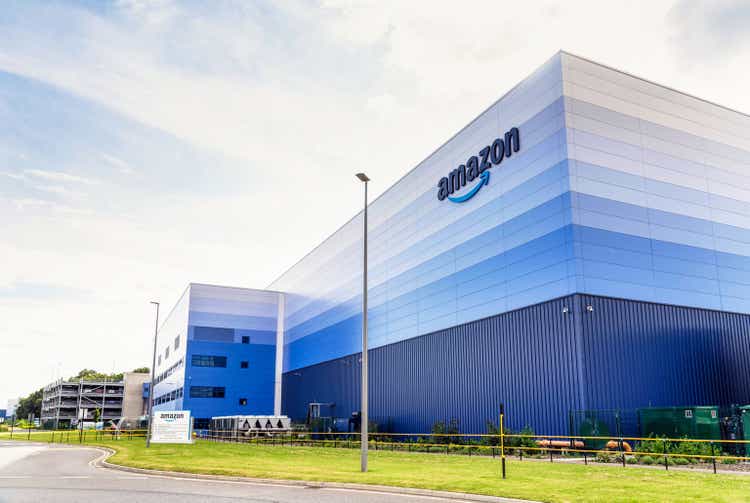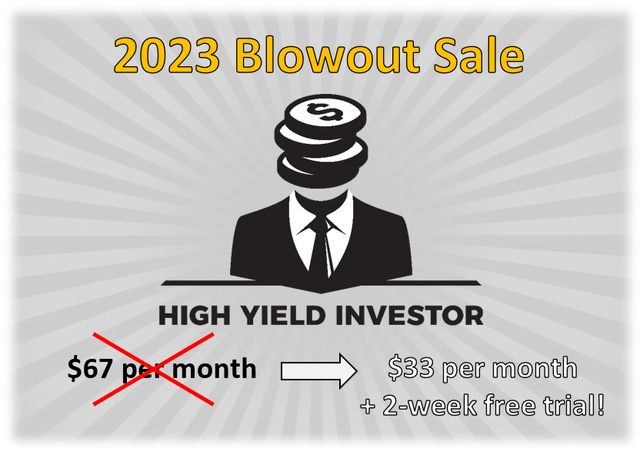2 Great Industrial REIT Buys: W. P. Carey And STAG Industrial
Summary
- Industrial real estate continues to enjoy strong tailwinds.
- WPC and STAG are among the best buys in the sector today.
- We compare them side by side and offer our take on which is the better buy at the moment.
- Looking for a portfolio of ideas like this one? Members of High Yield Investor get exclusive access to our subscriber-only portfolios. Learn More »
georgeclerk
Despite a general pullback in the prices of industrial REITs, the fundamentals for the industrial real estate sector remain strong. Industrial real estate properties have been enjoying historically low vacancy rates in recent quarters which have led to nationwide average YoY increase in rent rates of ~ 25%, the highest among any commercial real estate sector.
This tight market and strong rent growth are spurring a high degree of new development projects, but the pipeline of new developments is likely to be absorbed easily as they are completed. Although the combination of an economic slowdown and a spike in industrial deliveries may cool the rent growth, the industrial real estate fundamentals remain strong.
When looking at the sector, two industrial focused REITs stick out to us as offering particularly attractive risk-reward thanks to their high yields, solid organic growth rates, and investment grade balance sheets: W. P. Carey (NYSE:WPC) and STAG Industrial (NYSE:STAG). In this article, we compare them side by side and offer our take on which is the better buy at the moment.
WPC Stock Analysis
WPC invests primarily in industrial and warehouse real estate - but also has meaningful exposure to office, retail, and personal storage real estate - in the US and Europe, with around one-third of its rent coming from investment-grade tenants. It owns a diversified portfolio of approximately 1,500 properties and places great importance on ensuring its properties are strategically located and play a mission-critical role for its tenants. The majority of its rent is CPI-linked, which is uncommon in the triple net lease sector. Despite the challenges posed by COVID-19 lockdowns, WPC demonstrated resilience and performed better than most other triple net lease REITs.
WPC reported Q4 adjusted FFO per share of $1.29, slightly down from the previous year. However, the full year AFFO per share grew by 4.9% YoY, and portfolio occupancy remained strong at 98.8%. The company made significant investments, totaling $1.4 billion, and outpaced dispositions of $243.7 million. Despite management guiding for a full-year investment volume of ~$2 billion, the company expects weak AFFO per share growth of only 1.1% due to substantial lease expirations and debt maturities, with rising interest rates causing a meaningful headwind.
Meanwhile, its balance sheet remains very strong, recently earning an upgrade to a BBB+ credit rating from S&P. Furthermore, its valuation looks pretty attractive, with its 14.67x price to AFFO ratio and its 17.02x EV/EBITDA ratio both looking discounted relative to its five year averages of 14.75x and 17.84x, respectively, especially when considering that its portfolio has become increasingly focused on industrial real estate over that period and its credit rating has just been upgraded. Moreover, its 5.5% forward dividend yield combines with its strong same-store NOI growth (thanks to its large percentage of CPI-linked rent increases), to provide a strong yield plus growth combination.
If we assume some multiple expansion, add to that a 4.5% AFFO per share CAGR over the next five years, and then add on the 5.5% yield, the path to double-digit annualized returns alongside low risk appears quite clear and looks very worthy of an investment.
While some may point to its substantial debt and lease expirations in the coming two years as a major headwind that will prevent WPC from meeting our growth projections, there are several important factors to keep in mind. First and foremost, the debt that is maturing in the near term is among WPC's highest interest rate debt, while its really low rate debt is locked in for quite a few more years. As a result, refinancing the upcoming maturities should not pose as big of a headwind as it otherwise would have, especially when taking into account that WPC's recent credit rating upgrade should enhance its ability to attract reasonably-priced debt.
Second, cap rates are rising. WPC announced at the beginning of January that it had achieved an investment volume of $1.42 billion for 2022 and reported that cap rates had started to increase in Q4. The company made significant acquisitions of top-quality industrial and warehouse properties with cap rates ranging from the high sixes to the sevens. This has made management optimistic about the prospects for 2023, as they believe it will create an environment favorable to higher investment activity with wider spreads. This means that its expiring leases in the coming years should be able to be renewed at attractive cap rates, offsetting much of what otherwise would have been a headwind.
Third, WPC's stock continues to trade at a meaningful premium to NAV. As a result, it should be able to continue issuing equity at accretive levels relative to acquisitions.
STAG Stock Analysis
STAG's business model focuses on value-add investments in industrial real estate in secondary markets, giving it a margin of safety during economic downturns. By targeting properties with issues such as high vacancy rates or short lease terms, it can purchase them for less than market value and leverage its resources to create value. This approach provides greater downside protection in the event of a recession.
In Q4, STAG's core funds from operations decreased from Q3 but rose YoY, and its revenue exceeded analyst estimates. Total expenses increased from the prior quarter and YoY. Cash NOI and same-store cash NOI both rose YoY, but at a slower pace than in Q3. STAG commenced operating portfolio leases of 3.0M square feet in Q4, resulting in cash rent change of 14.2% and straight-line rent change of 25.4%. The total portfolio occupancy rate was 98.5% as of the end of the quarter.
Moving ahead, STAG's solid balance sheet, strong growth profile, and attractive valuation make us bullish on it, even if a recession hits.
STAG's balance sheet has low leverage, an investment grade BBB credit rating from S&P, $847 million in liquidity, and mostly fixed rate unsecured debt makes it a good fit in a stagflationary environment, providing it with flexibility and little increase in relative interest expense.
STAG has a lot of potential for growth, as it currently only owns less than 1% of its total addressable market. Given this robust growth pipeline, management has tried to maximize retained cash flows in order to fund its acquisitions. In 2023, management has guided that acquisition volume will range between $300 million and $700 million at a cash capitalization rate between 5.75% and 6.5%. Analysts anticipate that STAG will be able to grow its AFFO per share at a 5-6% CAGR in the coming years, driven by a combination of acquisitions and strong re-leasing spreads.
Meanwhile, the valuation also provides opportunity for upside in addition to the strong growth. Its dividend yield is currently 4.7%, while its price to AFFO ratio is just 16.1x, considerably below its five year average of 17.5x. Furthermore, its EV/EBITDA ratio is 15.9x, also well below its five year average of 17.4x. Last, but not least, its price to NAV ratio is 0.87x, indicating that the REIT is trading at a substantial discount to its estimated private market valuation.
When you combine the strong balance sheet, the strong growth momentum, and the discounted valuation, investors at current prices can get access to a compelling risk-reward profile. Adding just the yield and the expected growth rate gets investors a clear path to double-digit annualized total returns. When adding in likely valuation multiple expansion, the total return potential moves even higher.
Investor Takeaway
STAG is more of a pureplay industrial REIT whereas WPC is a diversified, industrial-majority REIT. Furthermore, STAG has slightly strong per share growth potential and also trades at a larger discount to its historical valuation multiples. As a result, its total return potential is superior to WPC's.
That said, WPC offers a meaningfully higher dividend yield and its business model is lower risk given its keen focus on high quality triple net leases and its superior credit rating. As a result, investors looking to maximize total returns in the industrial space while still adopting a moderate to low risk profile and an attractive current yield may prefer STAG, while investors focused on maximizing low risk yield in the industrial space should probably favor WPC.
In our view, this is not necessarily an either/or question, as both are quite attractively priced. We currently hold WPC among other similar opportunities in our Retirement Portfolio at High Yield Investor and think STAG is a great core holding for a more aggressive portfolio.
Our 2023 Blowout Sale of the Year is Here!
For a Limited-Time - You can join Seeking Alpha's #1 rated community of high-yield investors at a steep discount!

Try it Free for 2 weeks. If you don't like it, we won't charge you a penny! We have over 150 five-star reviews from happy members who are already profiting from our high-yield strategies.
We spend 1000s of hours and over $100,000 per year researching the market for the most profitable investment opportunities and share the results with you at a tiny fraction of the cost.
(Limited to only 50 spots!)
This article was written by
Samuel Smith is Vice President at Leonberg Capital and manages the High Yield Investor Seeking Alpha Marketplace Service.
Samuel is a Professional Engineer and Project Management Professional by training and holds a B.S. in Civil Engineering and Mathematics from the United States Military Academy at West Point. He is a former Army officer, land development project engineer, and lead investment analyst at Sure Dividend.
Disclosure: I/we have a beneficial long position in the shares of WPC either through stock ownership, options, or other derivatives. I wrote this article myself, and it expresses my own opinions. I am not receiving compensation for it (other than from Seeking Alpha). I have no business relationship with any company whose stock is mentioned in this article.


